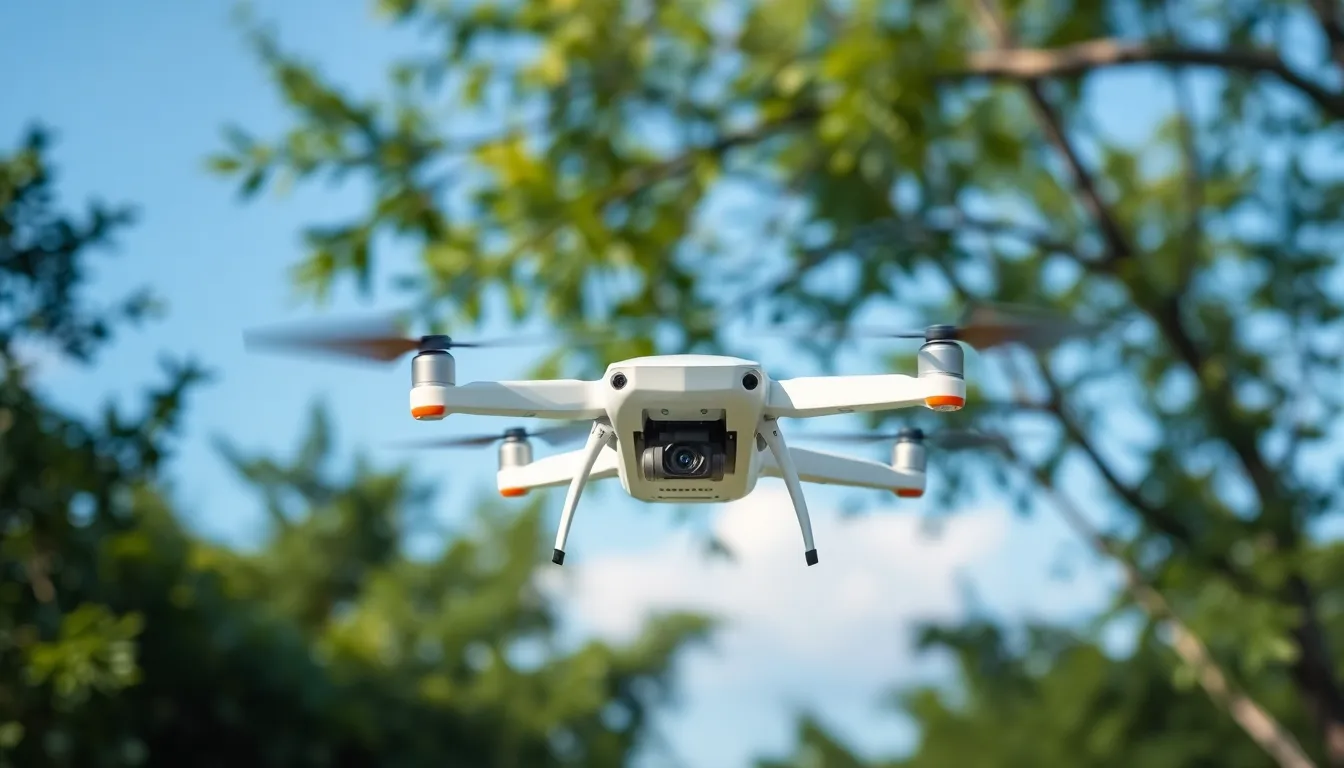In a world where noise pollution is an everyday annoyance, silent drones are swooping in to save the day—without making a peep. Imagine a drone that can deliver your pizza or capture stunning aerial shots without sounding like a swarm of angry bees. These stealthy marvels are not just a techie’s dream; they’re reshaping industries from delivery services to wildlife conservation.
Table of Contents
ToggleOverview of Silent Drones
Silent drones utilize innovative technology to significantly reduce noise levels during operation. These aircraft maintain efficiency while eliminating disruptive sound, making them suitable for diverse applications. Businesses leverage silent drones for various purposes, including food delivery and aerial surveillance.
A recent study showed that silent drones can operate at noise levels as low as 50 decibels, compared to traditional drones that often exceed 90 decibels. This reduction allows for stealthy operations in sensitive environments such as wildlife habitats.
Developers are incorporating advanced design features, including specialized motors and sound-dampening materials, to enhance quiet operation. Both commercial and recreational users benefit from these advancements. Wildlife researchers often rely on silent drones to monitor species without disturbing their natural behavior.
Industries such as agriculture also find value in silent drones for crop monitoring. They gather vital data while minimizing the impact on surrounding ecosystems. Urban areas experience reduced noise pollution with the deployment of silent drones for delivery services. City dwellers appreciate the quieter alternatives for food and package delivery.
Regulations supporting the use of silent drones are emerging, promoting their integration into existing airspace. There’s potential for growth in both functionality and market adoption.
Silent drones represent a pivotal shift in drone technology, focusing on minimizing noise while maximizing versatility across various sectors. Users recognize their potential to reshape industries by ensuring privacy and preserving wildlife tranquility.
Technology Behind Silent Drones

Silent drones utilize advanced technologies that significantly cut noise emissions. Their sophisticated design combines effective noise reduction techniques and innovative propulsion systems to deliver stealthy operation.
Noise Reduction Techniques
Engineers employ several noise reduction techniques to ensure quiet performance. They use specialized rotors designed to produce less turbulence. Sound-dampening materials line the drone’s frame, absorbing vibrations that generate noise. Additionally, optimizing the drone’s speed and altitude helps minimize sound production. Recent developments have achieved operational noise levels as low as 50 decibels, surpassing traditional models that commonly exceed 90 decibels. These innovations allow silent drones to operate discreetly, making them suitable for sensitive environments like wildlife habitats and urban delivery services.
Propulsion Systems
Modern silent drones feature propulsion systems that enhance their quiet operation. Developers integrate brushless motors, which run more quietly than conventional motors. Electric propulsion systems also contribute to reduced noise, maintaining efficiency without sacrificing performance. By utilizing variable pitch propellers, these drones can adjust their thrust while optimizing sound emissions. Advances in battery technology further enhance their operational capabilities, providing longer flight times without added noise. This integration of quiet propulsion technology positions silent drones as essential tools across industries.
Applications of Silent Drones
Silent drones find diverse applications across multiple sectors. Their design significantly enhances operational efficiency while minimizing disturbance.
Use in Military Operations
Military operations increasingly utilize silent drones for reconnaissance and surveillance. These drones excel in stealth missions, enabling personnel to gather intelligence without alerting adversaries. They operate discreetly, making it feasible to navigate sensitive areas while maintaining situational awareness. Noise reduction capabilities facilitate covert assessments, crucial in tactical environments. Additionally, modern silent drones allow for precise targeting and strike missions with reduced risk of detection. The ability to gather real-time information without emitting traditional drone noise enhances operational effectiveness.
Civilian Uses
Silent drones serve numerous civilian applications that benefit from low noise levels. Delivery services capitalize on these drones to transport goods, reducing urban noise pollution during operations. Their ability to operate quietly makes them ideal for residential areas, enabling services like food delivery and packages without causing disturbance. Agriculture also benefits as silent drones monitor crops, collecting data without creating stress for wildlife. Furthermore, filmmakers and photographers appreciate silent drones for capturing stunning aerial shots in environments where sound disruption would be detrimental. The versatility of silent drones in civilian sectors indicates their growing presence in everyday life.
Advantages of Silent Drones
Silent drones offer numerous advantages across various sectors, enhancing their utility and effectiveness. Noise reduction plays a critical role, enabling silent drones to operate in sensitive environments without disturbing wildlife or local communities. With sound levels as low as 50 decibels, these drones allow for stealthy reconnaissance missions in military applications, ensuring that operations remain covert.
Operational efficiency stands out as another significant benefit. Utilizing advanced design features such as sound-dampening materials and specialized motors, silent drones maintain high performance without generating disruptive noise. This efficiency translates into longer flight times and greater payload capacities, significantly improving service delivery in urban settings.
In delivery services, silent drones excel by transporting goods quietly and swiftly. Urban areas particularly benefit from this capability, as residents can receive food and packages without the associated noise of traditional drones. Retailers find these drones enhance customer satisfaction as deliveries become less intrusive.
Furthermore, agriculture reaps advantages from silent drones, aiding in crop monitoring and management with minimal disturbances to wildlife. Farmers utilize these drones to collect vital data, improving yields while respecting local ecosystems.
The entertainment industry also sees value, as filmmakers and photographers utilize silent drones for unobtrusive aerial shots. Capturing stunning visuals in sound-sensitive environments becomes possible, maintaining the tranquility of locations while achieving high-quality imagery.
As regulations evolve, the integration of silent drones into existing airspace continues to gain momentum. This growing acceptance promises expanded functionality and market adoption, indicating the potential for silent drones to reshape various industries effectively.
Challenges and Limitations
Silent drones face several challenges and limitations that affect their widespread adoption. Battery life remains a significant constraint, as longer flights require more energy. Pulled by advances in battery technology, developers work to extend flight durations, but current models often max out around 30 minutes before needing a recharge.
Regulatory hurdles complicate their integration into existing airspace. Authorities impose restrictions on drone operations, often prioritizing traditional models that meet existing regulations. Navigating these regulations requires ongoing dialogue between manufacturers and government agencies to ensure compliance and operational viability.
Performance in inclement weather poses another challenge. While silent drones excel in optimal conditions, rain and high winds can severely impact their functionality. Engineers continue to innovate materials and designs to improve weather resistance, but limitations still exist.
Public perception can influence acceptance. Concerns about privacy and safety often lead to resistance among communities. Addressing these grievances involves educational efforts and demonstrating the benefits of silent drones to the public.
Additionally, high development and manufacturing costs hinder widespread use. Manufacturers face expenses associated with advanced materials and technologies essential for noise reduction. Cost-effective solutions challenge developers as they aim to balance quality and affordability.
Finally, competition from traditional drones presents significant hurdles. Users drawn to the lower cost and availability of conventional models may be hesitant to invest in silent alternatives. Convincing consumers that the benefits of silent drones outweigh their costs is an ongoing challenge.
These challenges collectively shape the market dynamics for silent drones. Addressing these limitations will enable manufacturers to unlock the full potential of this burgeoning technology.
Silent drones are set to revolutionize how industries operate by minimizing noise while maximizing efficiency. Their quiet capabilities make them ideal for a variety of applications from delivery services to wildlife conservation. As technology advances and regulations adapt, the potential for silent drones to reshape urban landscapes and sensitive environments becomes increasingly clear.
While challenges remain in terms of battery life and public perception, the ongoing development in this field promises significant improvements. The future of silent drones looks bright as they continue to address noise pollution while delivering unparalleled versatility across sectors.









